We’ve all done it: planted something we love only to learn, sometimes years later, that it is invasive where we live. In many cases, we can be forgiven. If a nursery is selling it, the message conveyed is that all is well. There are fewer excuses now, when home research has never been easier and when awareness of invasive species has never been higher. Despite that, invasive plants are still being sold by many growers, and the desire for some of them sometimes overrides our internal ethicist. This list of 13 invasive plants includes some well known and understandably appealing garden ornamentals. Do not plant them, and do remove them if you are currently harboring plants whose spread alters and harms local ecosystems. An invasive plant does not stay home—it travels: by roots, runner, fruit, and seed.
But what about…?
Above: Japanese knotweed in bloom.
First, a disclaimer: this list of invasive plants is by no means complete and does not include plants like mugwort, Japanese knotweed, and garlic mustard, since we’re assuming (fingers crossed) that their notoriety precedes them and that they are probably not ornamentally tempting. But, by all means, add plants you feel should be addressed, in the comments.
Butterfly Bush
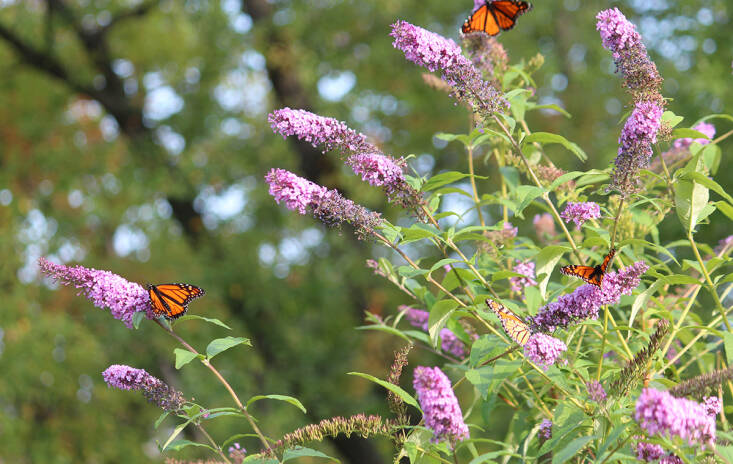 Above: Butterfly bush attracts butterflies but outcompetes native plants that feed their larvae.
Above: Butterfly bush attracts butterflies but outcompetes native plants that feed their larvae.
One of the most tempting invasive plants is butterfly bush. It smells delicious, is pretty, blooms repeatedly, and is irresistible to butterflies. What’s not to love? Consider, then, that invasive Buddleja davidii excels at producing tens of thousands of seeds per flowerhead, outcompeting native flowering shrubs whose leaves are food for butterflies. While the nectar of butterfly bush attracts adult butterflies, this shrub is not a host plant for their larvae (caterpillars), which cannot feed on its leaves. Newer, and so-called less-fertile butterfly bush cultivars still produce seed, just less of it. Avoid.
Plant native flowering shrubs, instead. Sweet pepperbush (Clethra alnifolia) is a good alternative to butterfly bush, with flowers, scent, and a lot of butterfly action in late summer.
Japanese Honeysuckle
 Above: Japanese honeysuckle smells wonderful but smothers shrubs and trees.
Above: Japanese honeysuckle smells wonderful but smothers shrubs and trees.
As appealing as its perfumed flowers may be, Lonicera japonica is now a serious botanical thug in wild places where it is not native. The scrambling vine uses shrubs and trees for support, creating dense, shaded thickets that alter the local ecosystem by smothering native seedlings. It is spread via its fruit, vexingly ripe during fall migration. Birds disperse the seed as they move south. Japanese honeysuckle also reproduces vegetatively, via above-ground runners and below-ground rhizomes.
An alternative to Japanese honeysuckle is of course a native honeysuckle, Lonicera sempervirens (but no scent, sorry). It is very attractive to hummingbirds. For a scented alternative, try star jasmine, (Trachelospermum jasminoides) or bee-friendly yellow jessamine (Carolina jasmine —Gelsemiun sempervirens).
Chinese and Japanese Wisteria
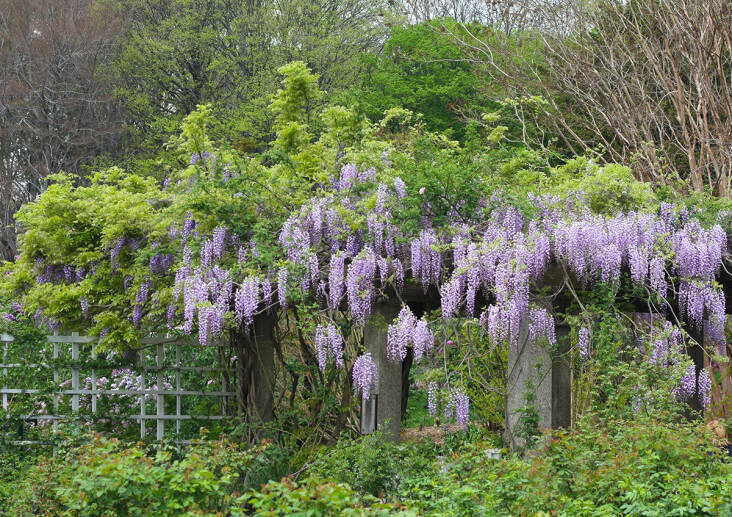 Above: Chinese wisteria at the Brooklyn Botanic Garden.
Above: Chinese wisteria at the Brooklyn Botanic Garden.
I admire the long panicles of Wisteria sinensis and W. floribunda dripping from pergolas in botanical gardens. And then I drive up the Palisades Parkway in New York and New Jersey and see the same vines cascading from the bent branches of oak, maple, and sycamore. It’s beautiful, but it’s deadly: the girlding vines of this wisteria cut through bark and cause gradual death. Their smothering habit also alters native forest ecologies. Wisteria spreads vegetatively, growing easily from cuttings and new shoots, and by seeds, which explode form their pods when ripe. Seeds also travel along waterways, to germinate downstream.
The substitute for introduced wisteria is an easy one. Grow the North American species, Wisteria frutescens. Its flowers appear after leaves have formed, and its amethyst panicles are fat and compact with blooms.
Lily of the Valley
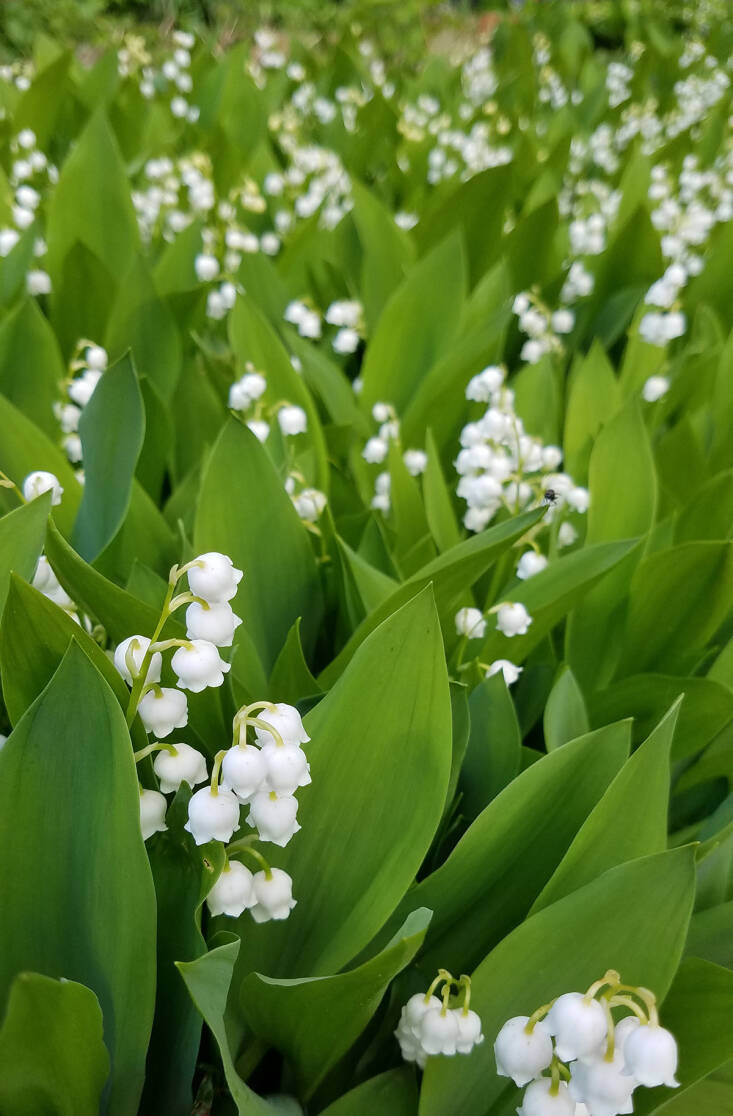 Above: Lily of the valley can create dense carpets on woodland floors, displacing native wildflowers.
Above: Lily of the valley can create dense carpets on woodland floors, displacing native wildflowers.
Invasive plants can be diminutive: Still on the subject of scent, alluring lily of the valley has wandered into forests beyond its garden confines. Convallaria majalis is native to Europe but relishes the high shade of arboreal North America, where it is an aggressive spreader.
Native alternatives to lily of the valley include Canada mayflower (Maianthemum canadense), other species of Maianthemum, like false Solomon’s seal, as well as native Solomon’s seal (Polygonatum biflorum).
Rosa Multiflora
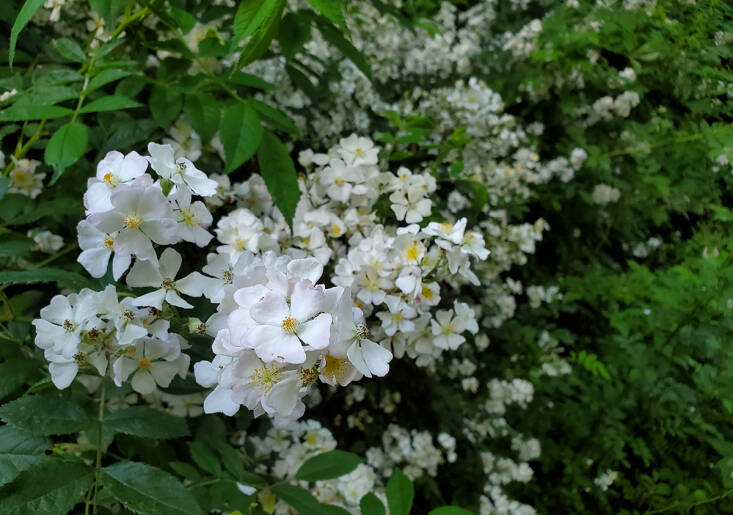 Above: Rosa multiflora produces thousands of flowers followed by thousands of rosehips.
Above: Rosa multiflora produces thousands of flowers followed by thousands of rosehips.
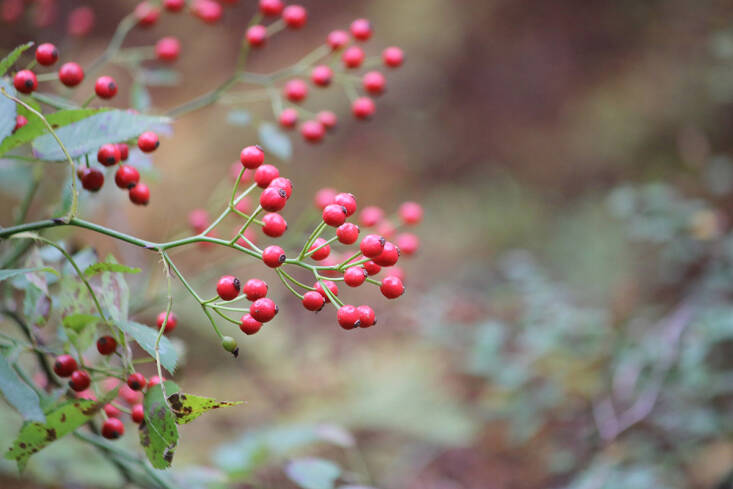 Above: The tiny but myriad rosehips of Rosa multiflora are relished by birds.
Above: The tiny but myriad rosehips of Rosa multiflora are relished by birds.
Pretty and floriferous Rosa multiflora is now a fixture of many Northeastern hedgerows, and woodland edges. This rambling, sharp-spined shrub roots where its canes touch the ground, and is also spread by rosehip-eating birds. Like Japanese honeysuckle and privet, the fruit is ripe during fall migration. And off it goes.
Substitute once-blooming multiflora rose with native rose species.
Beach Rose
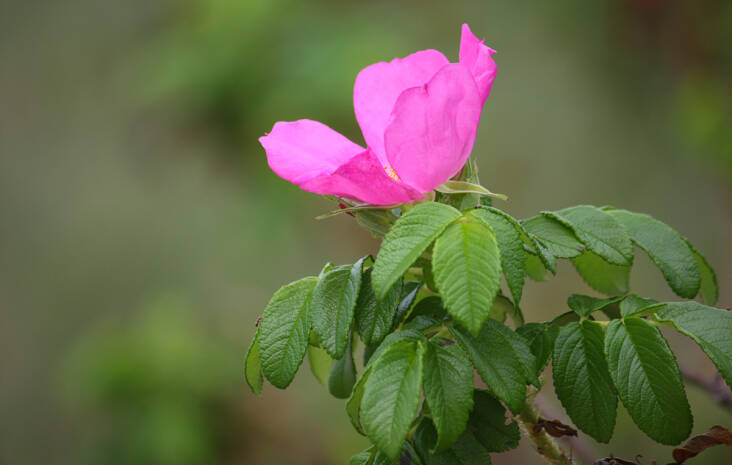 Above: Beach rose is native to East Asia.
Above: Beach rose is native to East Asia.
Invasive plants can persuade us that they belong: such is the case with attractive, large-hipped beach rose, Rosa rugosa, which is often assumed to be a shoreline native. It is not. It has simply taken hold, impervious to salt spray and wind. Its plump hips are stuffed with seeds, and these are spread by animals and birds. (They’re good for humans to eat and you may collect as many as you like.)
Instead of beach rose, plant native Rosa virginiana.
Privet
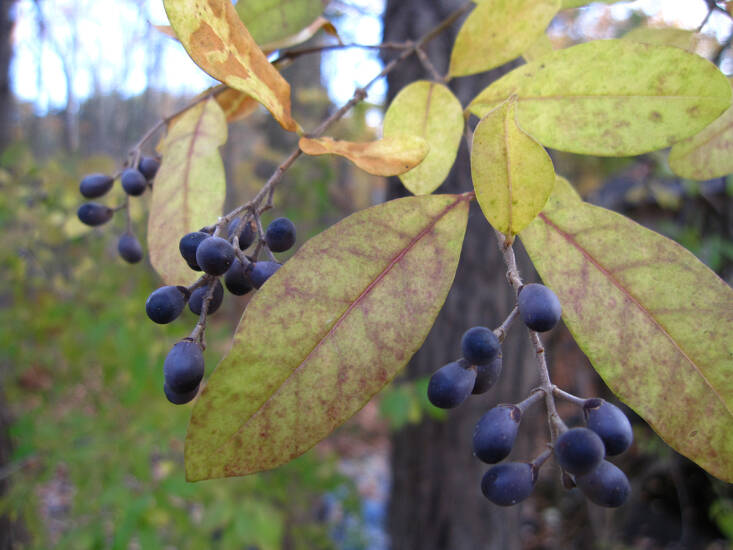 Above: Privet’s ripe drupes are fodder for migrating birds; but that is how the invasive shrub spreads.
Above: Privet’s ripe drupes are fodder for migrating birds; but that is how the invasive shrub spreads.
Often used in hedging, species of Ligustrum are spread further afield, every year, by birds and other animals that eat their fall-ripe drupes. Shearing the shrubs flowering after bloom can help prevent fruit-set.
Native flowering shrub alternatives to privet include ninebark (Physocarpus opulifolius) and arrowwood viburnum, (Viburnum dentatum).
Burning Bush
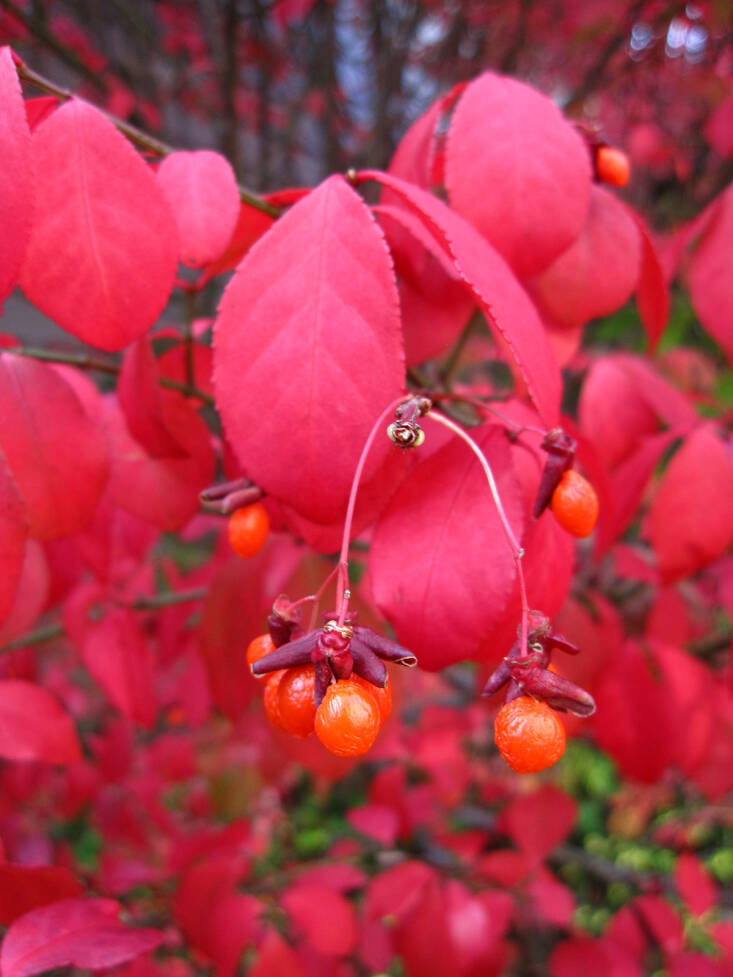 Above: Winged euonymus is also known as burning bush.
Above: Winged euonymus is also known as burning bush.
Saturated with scarlet in autumn, winged euonymus, or burning bush, is striking. But is has also infested forests, outcompeted only by barberry. This is the plant to dig out at once. Its fruit are its main form of dispersal and autumn is upon us.
For blazing fall color, substitute native blueberry or chokeberry (Aronia species), both beneficial to humans and wildlife as well.
Autumn Olive, Oleaster, Japanese Silverberry
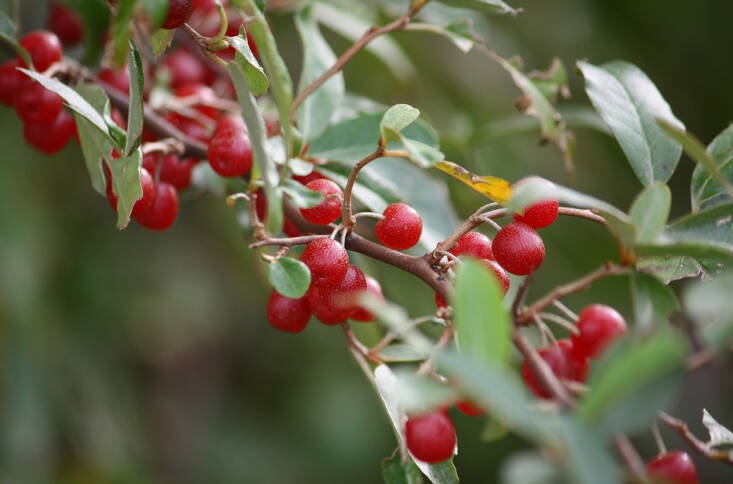 Above: The ripe, edible fruit of autumn olives.
Above: The ripe, edible fruit of autumn olives.
Seriously invasive autumn olive is Elaeagnus umbellata, whose heavily fragrant spring flowers are often called oleaster (even though that plant is invasive E. angustifolia, or Russian olive, whose fruits are oblong and green rather than juicily red). Either way, these attractive silver-leafed small trees are responsible for diminished biodiversity where they flourish.
As an alternative to autumn olive try Amelanchier species (for spring flowers and summer fruit) or pussy willow (Salix discolor) for willowy leaves and bonus spring catkins.
Barberry
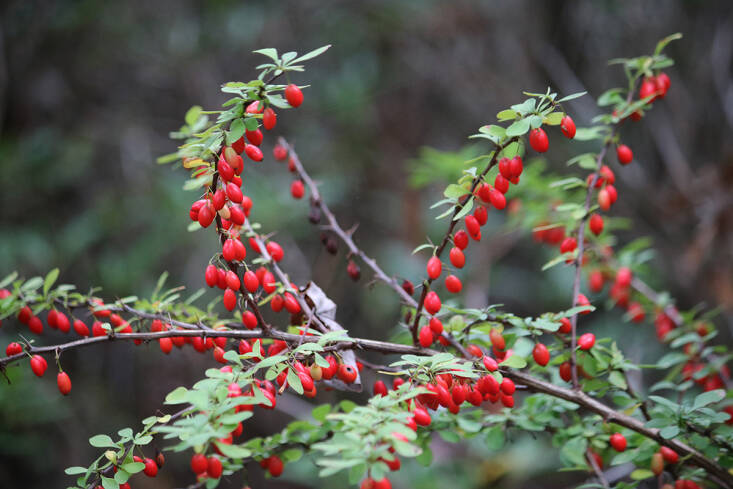
Barberry was used frequently in professional landscape design. Its spring flowers, tightly clipped form in formal settings, and fall berries made it appealing. But the thorny story of invasive Japanese and common barberry keeps developing. Aside from cluttering forest floors with their densely-branched thickets—in so doing altering the growing conditions for native plants and the insect, bird and animal life that has evolved with them—it is now clear that (for reasons that are still unclear), tick populations are significantly higher where these barberries grow.
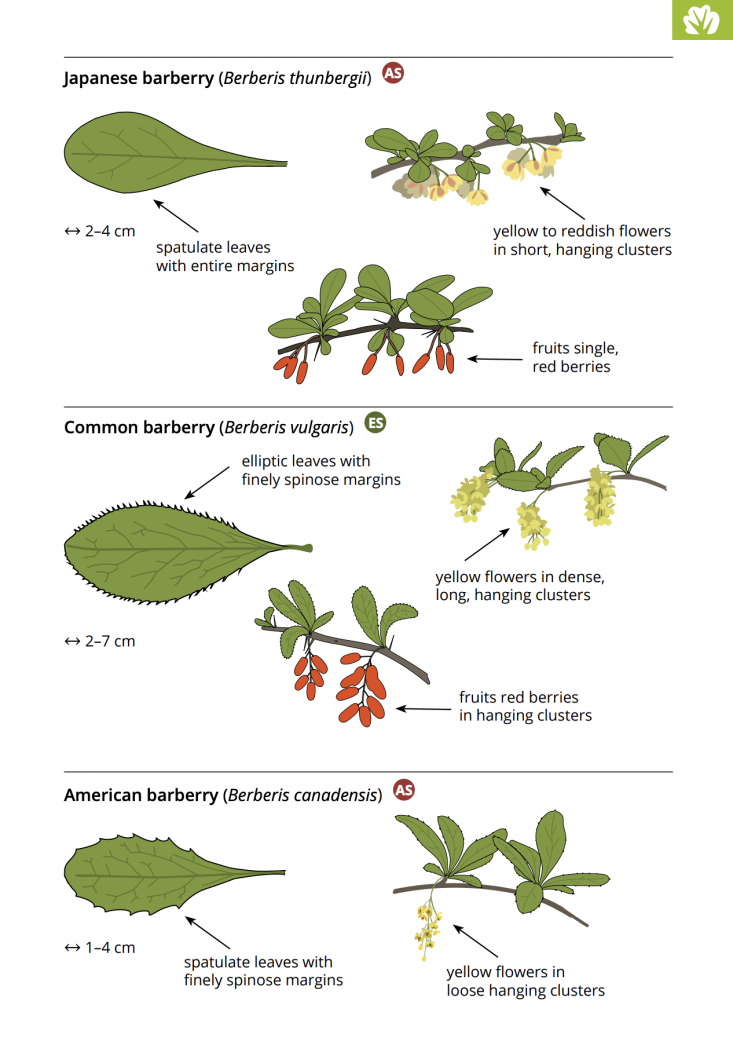 Above: This useful diagram illustrates the differences between native and invasive barberries. From A Field Guide to Invasive Alien Species in European Forests.
Above: This useful diagram illustrates the differences between native and invasive barberries. From A Field Guide to Invasive Alien Species in European Forests.
An aside: One of the most helpful identification guides for barberry and other invasive plants comes from a A Field Guide to Invasive Alien Species in European Forests, a book whose origins are European. Published by Institute Symbiosis in Slovenia and the Silva Slovenica Publishing Centre, Slovenian Forestry Institute, it is now available in English, online and for free, with remarkable relevance to North America, too.
Native substitutes for invasive barberries include ninebark, again (Physocarpus opulifolius, purple or green forms), which responds well to clipping, and densely-leafed fragrant sumac, Rhus aromatica.
Porcelain Vine, Porcelain Berry, Amur Peppervine
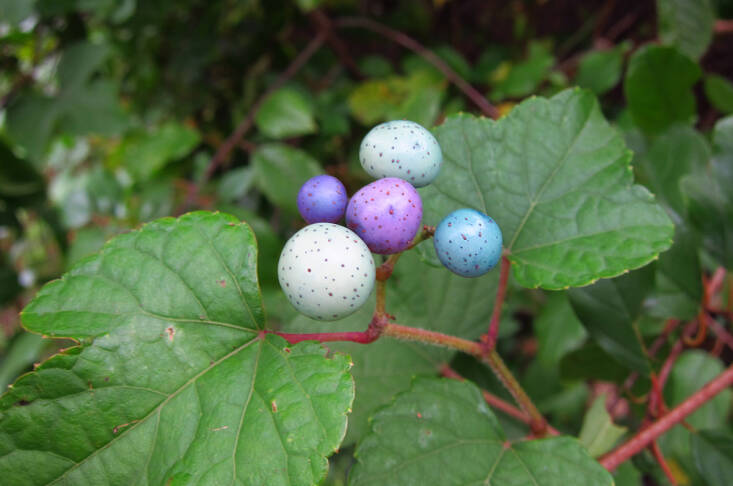 Above: The beautiful, bird-friendly fruit of very invasive porcelain vine.
Above: The beautiful, bird-friendly fruit of very invasive porcelain vine.
I once planted porcelain vine. I worked for a nursery that sold it as an ornamental. Recently, I have spent nine hours over several days weeding tenacious porcelain vines from a neglected public garden in New York City. Karma. As exquisite as these fall fruits are, consider the consequences, which are an unchecked spread well beyond the spot where your vine grows.
Native grapes (to which this invasive vine related) would be an appropriate substitute for porcelain vine, although their habit is almost as vigorous.
Asian Bittersweet
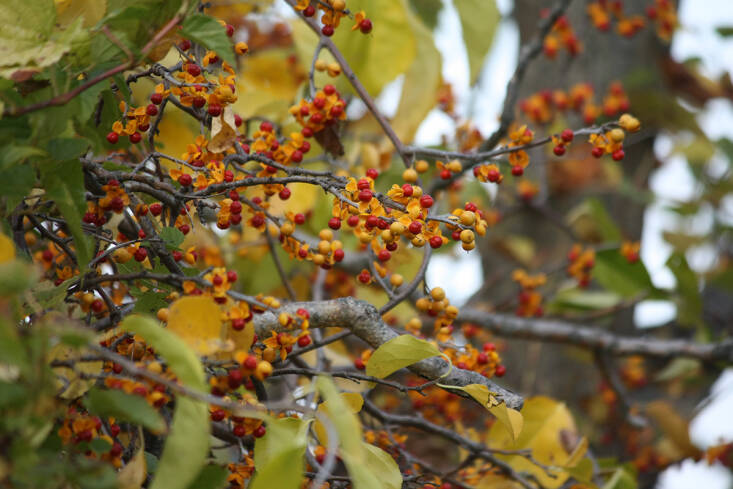
The twining vines of Asian bittersweet (Celastris orbiculatus) are tough and woody, and the plant’s rambunctious nature brings down trees and smothers shrubs. Its festive seed capsules burst open in fall, making its late-season appeal to gardeners who did not know better, understandable.
Its native cousin is American bittersweet, whose fruits are all-orange, versus yellow and scarlet.
Purple Loosestrife
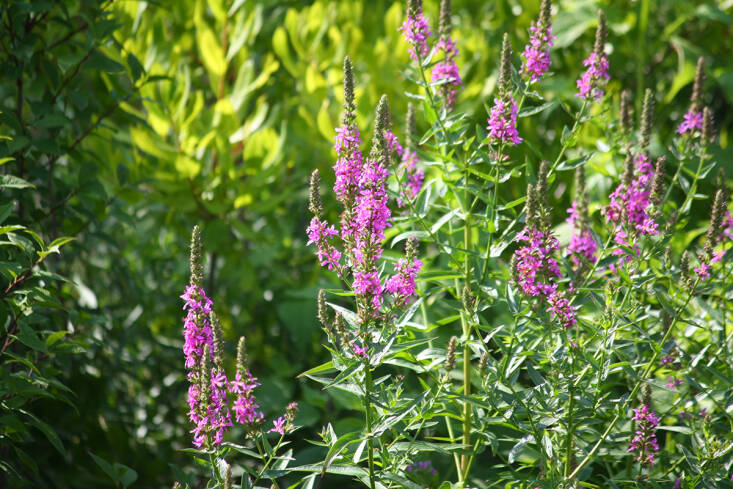 Above: Purple loosestrife has invaded wetland edges.
Above: Purple loosestrife has invaded wetland edges.
Early in my garden designing life, I was looking for plants that would work well as pops of color in a containerised meadow setting. A grower on Long Island enthused about purple loosestrife. I know better now. Where some people might see beauty in the hot pink swathes of purple loosestrife that crowd wetland edges, I see a telescoping of biodiversity and increased pressure on a sensitive system. Wetlands are—or should be—among the most biodiverse ecosystems on the planet. But this diversity is choked off when a single species dominates. Already under threat from Phragmites, our wetlands do not need more loosestrife.
Plant red or blue cardinal flowers, instead (Lobelia cardinalis or L. syphilitica).
See also:



